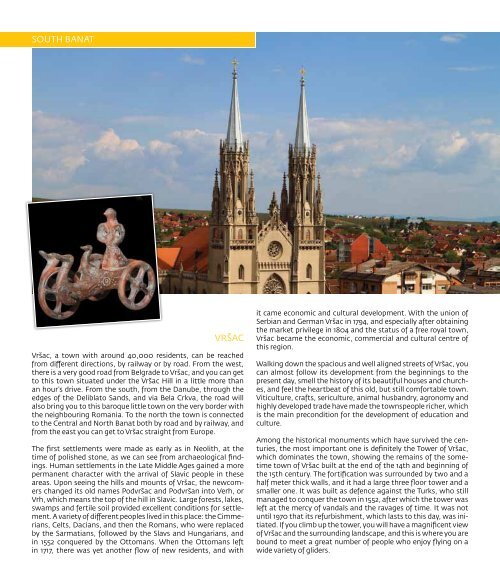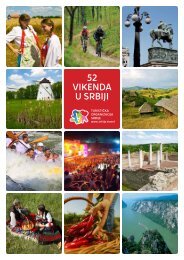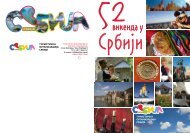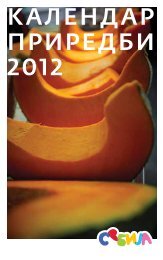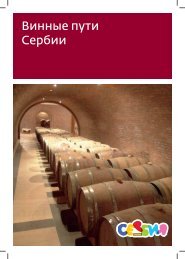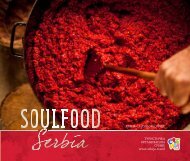of rUral Serbia
of rUral Serbia
of rUral Serbia
You also want an ePaper? Increase the reach of your titles
YUMPU automatically turns print PDFs into web optimized ePapers that Google loves.
SOUTH BANAT<br />
Vršac<br />
Vršac, a town with around 40,000 residents, can be reached<br />
from different directions, by railway or by road. From the west,<br />
there is a very good road from Belgrade to Vršac, and you can get<br />
to this town situated under the Vršac Hill in a little more than<br />
an hour’s drive. From the south, from the Danube, through the<br />
edges <strong>of</strong> the Deliblato Sands, and via Bela Crkva, the road will<br />
also bring you to this baroque little town on the very border with<br />
the neighbouring Romania. To the north the town is connected<br />
to the Central and North Banat both by road and by railway, and<br />
from the east you can get to Vršac straight from Europe.<br />
The first settlements were made as early as in Neolith, at the<br />
time <strong>of</strong> polished stone, as we can see from archaeological findings.<br />
Human settlements in the Late Middle Ages gained a more<br />
permanent character with the arrival <strong>of</strong> Slavic people in these<br />
areas. Upon seeing the hills and mounts <strong>of</strong> Vršac, the newcomers<br />
changed its old names Podvršac and Podvršan into Verh, or<br />
Vrh, which means the top <strong>of</strong> the hill in Slavic. Large forests, lakes,<br />
swamps and fertile soil provided excellent conditions for settlement.<br />
A variety <strong>of</strong> different peoples lived in this place: the Cimmerians,<br />
Celts, Dacians, and then the Romans, who were replaced<br />
by the Sarmatians, followed by the Slavs and Hungarians, and<br />
in 1552 conquered by the Ottomans. When the Ottomans left<br />
in 1717, there was yet another flow <strong>of</strong> new residents, and with<br />
it came economic and cultural development. With the union <strong>of</strong><br />
<strong>Serbia</strong>n and German Vršac in 1794, and especially after obtaining<br />
the market privilege in 1804 and the status <strong>of</strong> a free royal town,<br />
Vršac became the economic, commercial and cultural centre <strong>of</strong><br />
this region.<br />
Walking down the spacious and well aligned streets <strong>of</strong> Vršac, you<br />
can almost follow its development from the beginnings to the<br />
present day, smell the history <strong>of</strong> its beautiful houses and churches,<br />
and feel the heartbeat <strong>of</strong> this old, but still comfortable town.<br />
Viticulture, crafts, sericulture, animal husbandry, agronomy and<br />
highly developed trade have made the townspeople richer, which<br />
is the main precondition for the development <strong>of</strong> education and<br />
culture.<br />
Among the historical monuments which have survived the centuries,<br />
the most important one is definitely the Tower <strong>of</strong> Vršac,<br />
which dominates the town, showing the remains <strong>of</strong> the sometime<br />
town <strong>of</strong> Vršac built at the end <strong>of</strong> the 14th and beginning <strong>of</strong><br />
the 15th century. The fortification was surrounded by two and a<br />
half meter thick walls, and it had a large three floor tower and a<br />
smaller one. It was built as defence against the Turks, who still<br />
managed to conquer the town in 1552, after which the tower was<br />
left at the mercy <strong>of</strong> vandals and the ravages <strong>of</strong> time. It was not<br />
until 1970 that its refurbishment, which lasts to this day, was initiated.<br />
If you climb up the tower, you will have a magnificent view<br />
<strong>of</strong> Vršac and the surrounding landscape, and this is where you are<br />
bound to meet a great number <strong>of</strong> people who enjoy flying on a<br />
wide variety <strong>of</strong> gliders.


